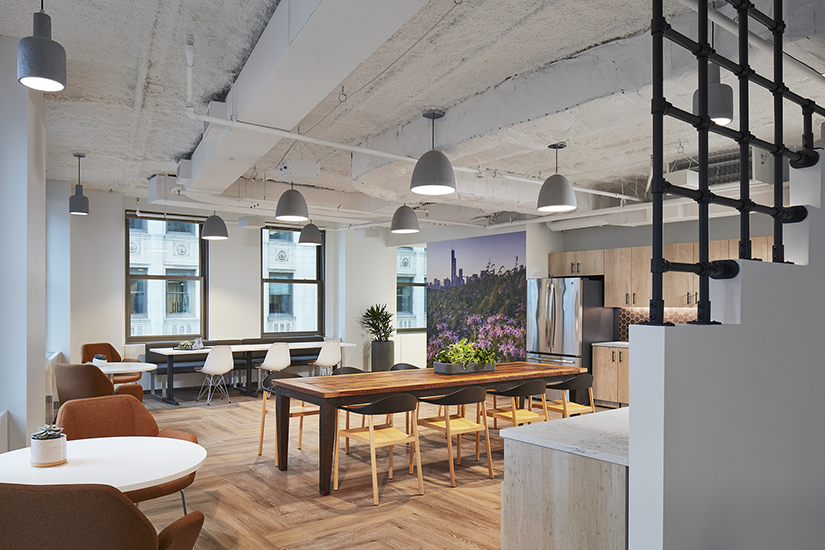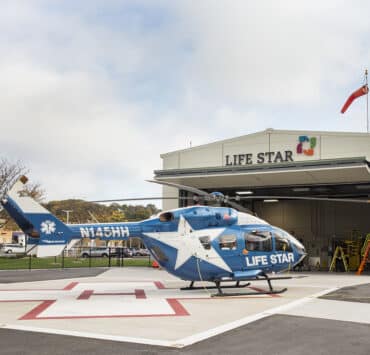|
Getting your Trinity Audio player ready...
|
The place where the Chicago River runs under Michigan Avenue’s bascule DuSable Bridge—with luxury hotels and retailers, high rise condos, and office towers all around—isn’t something most people would describe as a “habitat.” But for the Windy City office of the Nature Conservancy (TNC), this intersection is a home that is no less organic than the river is for the fish that swim there.

In early 2021 TNC moved into the 11th floor of the south tower of the century-old, terra-cotta-clad Wrigley Building seated at this section of the river. And as an architectural staple to Chicago, it’s no wonder that the Wrigley Building was the chosen location for the global environmental organization’s Illinois Program headquarters. “Our work embodies the city,” says Georgie Geraghty, deputy director of TNC.
As she describes it, the move here puts staff smack-dab in the middle of the geography that defines Chicago—past, present, and future. The river, for example, holds importance to the Native Americans who first called it home and is what led to the city’s establishment. It’s fed by Lake Michigan, which annually draws millions of migrating birds and tourists alike.
Today, the location provides an ecosystem for accomplishing the mission of TNC. Its central placement makes for an easy commute for staffers, but also keeps it accessible to the people and services who support the work of the organization, which includes tackling climate change, preserving land and water, providing food and water sustainability, and building healthy cities.
The Chicago outpost of the Arlington, Virginia-based international organization is primarily focused on more than 100 prairies, forests, savannas, rivers, and wetlands in Illinois. But global leaders and subject-matter experts work out of Chicago as well. So after a quarter century in less-than-inviting office space, which included an unfortunate degree of windowless conference and work spaces, a lease expiration provided the opportunity to try something new, different, modern, and, as things worked out, exhilarating.

Across 9,325 square feet of the space, occupying a full floor, private offices are nonexistent while open concept task areas dominate. There are still booth-like areas for individuals to focus on their tasks, but Geraghty explains that interaction between staff and others is key to how they function.
“Collaboration is the hallmark of our work,” she says. “We deal with thorny problems, often seminal issues with no clear path. We have development specialists, writers, operations managers, event planners, scientists, and conservation staff. Also, we convene advisory committees, a board of trustees, and myriad other committees. To function they have to understand and work with each other.”
It’s a vast departure from the previously drab offices reminiscent of an outdated era that they left behind. And yet to make this radical change, input from several vendors and staff was essential.
The search for new space began in 2019 before the pandemic hit. Geraghty worked with JLL, a leading commercial real estate firm, along with Whitney, an architecture and interior design firm, as well as a core group of staff and trustee experts to identify the location and develop the design program. TNC’s marching orders were to make it employee-centric, keep it within the nonprofit’s budget parameters, and make the build-out consistent with TNC sustainability and diversity values. Material costs were kept to a minimum, thanks to the builders (Executive Construction) negotiating best prices.
While the lease and the design were largely in place before the 2020 pandemic shutdown began, the build-out and move happened during its height. As staff continued to work from home, Geraghty personally boxed up their paper files and personal effects for the move itself.
Where did those boxes land when there are no dedicated offices? “There was a lot of anxiety over this,” Geraghty reveals. “But the JLL and Whitney people encouraged us to not see it as an A versus B situation in comparing old and new spaces.” She points out that staff will have choices (coat closets, cubby holes, lockers, and bench seat storage) as well as the freedom to set up workstations that fit their task and mood.

A few reminders of close-by environmental matters greet all arrivals at the new office reception desk. Made from reclaimed ash of trees lost to the emerald ash borer, an invasive species that wreaked havoc on North American forests and neighborhoods, the desk sits among furniture that was recycled, upcycled, and refurbished. Glass vials on a display wall hold such things as seeds from native prairie vegetation and mollusk shells.
“Everywhere you go in this office offers variety,” says Geraghty, who delights in observing kayakers on the formerly polluted river. “I love to take in the views, the natural light, and feel the hum of the city all around.”
In other words, it’s an urban ecosystem.


